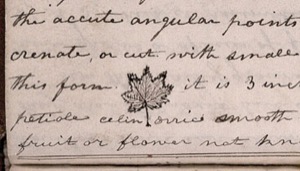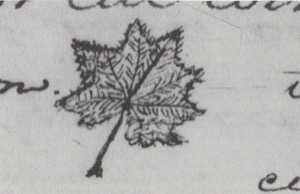February 10, 1806
[Lewis]
Drewyer visited his traps today but caught no beaver. Collins and Wiser returned had killed no Elk. Willard arrived late in the evening from the Saltworks, had cut his knee very badly with his tommahawk. he had killed four Elk not far from the Salt works the day before yesterday, which he had butched and took a part of the meat to camp, but having cut his knee was unable to be longer ucefull at the works and had returned. he informed us that Bratton was very unwell, and that Gibson was so sick that he could not set up or walk alone and had desired him to ask us to have him brought to the Fort. Coalter also returned this evening. continue the operation of drying our meat.
There is a tree [1] common to the Columbia river below the entrance of cataract river [2] which in it's appearance when divested of it's foliage, much resembles the white ash; the appearance of the wood and bark is also that of the ash. it's stem is simple branching and diffuse. the leaf is petiolate, plane, scattered, palmate lobate, divided by four deep sinuses; the lobes are repand, or terminate in from 3 to 5 accute angular points, while their margins are indented with irregular and somewhat circular incissures. the petiole is celendric smooth and 7 inches long. the leaf 8 inches in length and 12 in bredth. this tree is frequently 3 feet in diameter and rises to 40 or 50 feet high. the fruit is a winged seed somewhate like the maple. in the same part of the country there is also another growth [3] which resembles the white maple in it's appearance, only that it is by no means so large; seldom being more than from 6 to 9 inches in diamater, and from 15 to 20 feet high; they frequently grow in clusters as if from the same bed of roots spreading and leaning outwards. the twigs are long and slender. the stems simple branching. the bark smooth and in colour resembling that of the white maple. the leaf is petiolate, plane, scattered nearly circular, with it's margin cut with accute angular incissures of an inch in length and from six to 8 in number the accute angular points formed by which incissures are crenate, or cut with small accute angular incissures. or in this form. [4] it is 3 inches in length, and 4 in width. the petiole celindric smooth and one and a ¼ inches long. the fruit or flower not known.
[Clark]
Collins and Wiser returned without killing any Elk. Willard arrived late this evening from the Salt Camp, he had cut his knee very badly with his tomahawk. he had killed four Elk not far from the Salt Camp, the day before yesterday, which he had butchered and took a part of the meat to the Camp, but haveing Cut his Knee was unable to be longer Servisable at the works & had returned. he informed us that Bratten was very unwell, and that Gibson was So Sick that he could not Set up or walk alone, and had desired him to ask us to have him brought to the Fort. Colter also returnd. this evening. continue the opperation of dryin our meat.
There is a tree common to the Columbia river below the enterance of Cataract River which in its appearance when divested of its folage, much resembles the white ash; the appearance of the wood and bark is also that of the ash. it's Stem is Simple branching and diffuse. the lief is petiolate, plane, scattered palmate lobate, divided by four deep Sinusus; 〈Scattered〉 the lobes are repand or terminate in from 3 to 5 accute angular points, while their margins are indented with irregular and Somewhat Circular incissures. the peteole is Celindric Smoth and 7 inches long. the leaf 8 inches in length and 12 in bredth. this tree is frequently 2 & 3 feet in diamieter, and rises to 50 or 60 feet high—the froot is a winged Seed Somewhat like the maple. In the Same part of the countrey there is also another groth, which resembles the white maple in its appearance, only that it is by no means so large, seldom being more than from 6 to 9 inches in diamieter, and from 20 to 30 feet high; they frequently grow in clusters as if from the same bed or root, Spreading and leaning outwards. the twigs are long and Slender. the Stems simple branching. the bark Smoth and in Colour resembles that of the white maple. the leaf is patiolate, plain, scattered nearly circular, with it's margin cut with accute anglar incissures of an inch in length and from 6 to 8 in number, the accute angular points formed, by which incissures, are crenate, or cut with small angular incissures. or in this form. [5] it is 3 inches in length, and 4 in width. the petiole is cilendric smoth and 1¼ inches long. the froot or flour I have not as yet found out &c.
[Ordway]
Monday 10th Feby. 1806. a fair morning. a little Snow fell last night. in the afternoon two men [6] came in from the Salt works and informed us that Gibson is verry Sick at the Salt works and Bretn [7] verry unwell. the 2 men who came had killed 5 Elk but got only a little of it at the Salt works.—
[Gass]
Monday 10th. A light snow fell last night, and the morning was pleasant. In the afternoon two men came from the salt works, [8] with information that two others were sick and a third had cut his knee so badly he could scarcely walk.
[Whitehouse]
Monday Febry 10th We had some Snow fell during last night and this morning the weather was clear & pleasant. In the evening, two of our Men came in to the fort from the Camp, where our people were making salt, they informed us, that one of the Men there, was very sick, and another of the Men there, was unwell, they told us also that they had killed 6 Elk, but did not save much of the Meat. The two hunters who went out Yesterday, returned to the fort, but had kill'd no kind of Game.—




